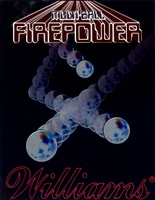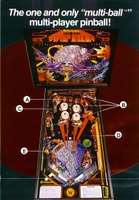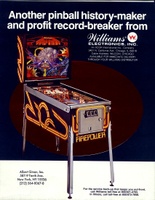

Firepower
For several Williams games (especially before 1987), Speech Processing was a separate task than Software Programming and may have been done by a different person than whom we list as having done the Software. Paul Dussault did the Speech Processing for this game. Eugene Jarvis told us that the background sound for Firepower, and all the other sounds for Firepower, were his own design. There is an excellent Firepower website at http://www.firepowerpinball.com/ Reportedly, the only differences between the L2 and L6 software are the price presets 1, 2, and 3, and the number of maximum credits. We asked Steve Ritchie about the first instance of the Lane Change feature, and if other pinball machines at that time might have had similar lane-changing except controlled by a CPU instead of a flipper button. He replies:FP was the first. One night I asked Eugene Jarvis if he could "move an unlit light under a ball coming down the lane with the right flipper switch." He said, "yes", and built the code. That same night at Williams we were using Lane Change. No CPU was changing lanes at the time either.He also puts to rest any belief that Williams' 1980 'Blackout' was the first game with Lane Change simply because its model number 495 preceded Firepower's number 497:Blackout was manufactured and designed WELL after Firepower. Williams produced many games out of model number order. Steve comments about the prototype version:The first 10 games we built had 2 3-banks of drops in place of the standups. They were so crappy that they were making the game unreliable, so we went with the standups for production. It was a smart move. If we had good drop targets it would have sold 20,000, but it wasn't working long enough to earn anything with the bad drops.... Pictured in this listing is a cabinet having a bottom panel design resembling a brick wall. We do not know how many came from the factory with this "brick bottom". Steve comments about this and about another idea considered for cabinet construction:Williams often made 2 sets of stencils for 2 different cabinet companies many times. We were selling so many pinball machines that we required at least 2 if not 3 "wood butchers" to keep up with demand, and they were Electronic Sound, Churchill Cabinet, and sometimes Lenk-Smith. There may have been others as well. I seem to remember that we got the brick pattern Masonite for cabinet bottoms because of a production shortage of un-printed Masonite. The tacky brick pattern stuff was popular for paneling basements. Williams probably paid less for the printed stuff, and it was probably all that could be had at the time. Particle board (MDF) was experimented with on pinball cabinets, and a few were built with disastrous effects. This was due to wishful thinking on the part of some "new guy" engineers and greed on the part of Williams' management. A group of us condemned the concept because we knew that there was no hope of making an MDF cabinet that would be as durable (and light!!..operators hated the already-heavy pinball machine becoming obese, and the increased shipping weight and $$) as plywood.The "brick bottom" shows up on other games made in 1980: Stern's 1980 'Seawitch' and Stern's 1980 'Quicksilver'. A machine with an ornate design on its bottom has been found and is pictured in this listing. Also pictured here is an NOS clear coated playfield with its edge ink-stamped 1982, dated after the original production run had ended and therefore was likely one of many made as replacement stock. Unlike the original run, this playfield has "starburst" pattern inserts and the huge round spaceship in the lower playfield has a red hue.






































































